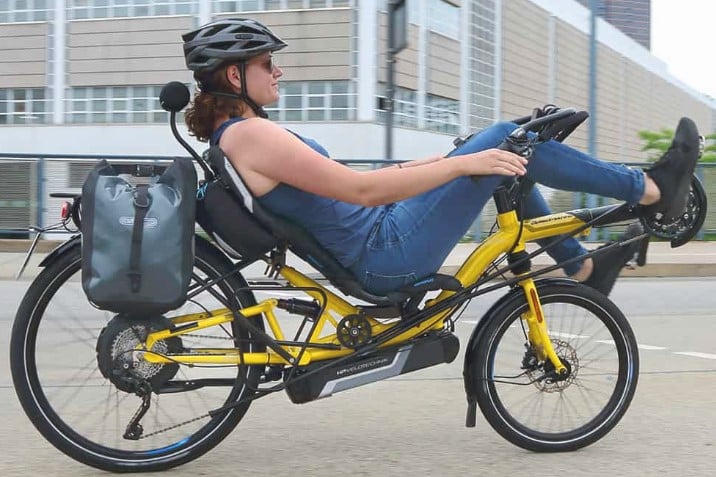They sure don’t look ordinary nor banal. The amazing recumbent ebikes and e-trikes offer some advantages in some particular cases.
The first time we stumbled upon a recumbent bike, we thought it was a bit eccentric, almost weird. Then a closer look opened our mind.
Recumbent Ebikes and e-trikes advantages, compared to two wheel e-bikes
- They are more aerodynamic, thus enabling higher speeds on flat
- the rider position can be less tiring for certain muscles and bones
- they could enable older people to longer endure longer trips
- they could allow a quicker physical recovery from biking efforts
- increased forward visibility, since they enable a 180° neck rotation
- their seats are more comfortable than a saddle
- they can more easily carry even bulky loads

Bike speeds following rider’s position – image courtesy of YouTube – www.guyetsamachine.fr
Exclusive advantages of recumbent e-trikes
- when idle, they are a relaxing chair
- they are more apt to carry solar panels
- hardly any danger of falling, no matter how old the rider
- definitely more viable for low mobility and handicapped people
- they can be streamlined, or faired

Hasebike Kett Evo Steps
Rcumbent Ebikes and e-trikes disadvantages, compared to regular ebikes:
- scarcely visible, even dangerous, a pennant should be mandatory
- quite slower to reach cruise speed when starting from zero
- neither gravity effect nor body mass weight helping to push the pedals down
- they make your back sweat, since is not exposed to airflow
- leg muscles are conceived to work in a standing position, not laying down
- inferior backwater visibility, a rearview mirror is a must
- manoeuvrability is also reduced: you need control and space to change lanes between stopped vehicles
- their steering radius is large: it’s impossible to make a u-turn on a narrow road
- they are heavier, especially e-trikes, therefore less apt to climb
- way more expensive

Icetrikes e-trikes – image courtesy of Icetrikes
Exclusive disadvantages of recumbent e-trikes
- there are no bike racks for them
- it takes at least a big station wagon to transport them
- they are cumbersome even in a garage

Hasebike Pino-Cargo tandem – image courtesy of Hasebike
They’ve beaten several records, in their streamlined versions
Nowadays, modern versions of this type of fully streamlined bike have reached records of over 90 km covered in one hour.
On September 18, 2009, Canada’s Sam Whittingham, already the world’s fastest man for several years, reached 133.28 km/h on his Varna Tempest between two points 200 m apart, on the flat, without the aid of any motor. On the same day, France’s Barbara Buatois reached 121.437 km/h on Varna Diablo III, a record she raised to 121.81 km/h on Varna Tempest a year later, on September 15, 20105. They also both broke the hour record on July 19, 2009, with the men’s record subsequently improved on August 3, 2011 by Francesco Russo on Elvistretto.

Hasebike Pino Steps tandem – image courtesy of Hasebike
Crank arms for recumbent eBikes
It’s worth noting that with a recumbent bike, electric or not, it’s better to use slightly shorter cranks that allow you to grind at high cadence (>80-90 RPM). It’s true that the recumbent position allows you to push harder, but it also puts more strain on your joints and tendons, which can be painful if you’re not careful.
Recumbent bikes by the numbers
There are an estimated 5,000 to 6,000 recumbent bikes in the world, electrified versions being probably 1/3 of the total. Recumbent bikes manufacturers are about 50, some of them are in Germany, France and United Kingdom.
Prominent recumbent e-bikes manufacturers
Two German ones: Hpvelotechnik and Hasebikes, and the British Icetrikes are surely among the leaders in Europe.
